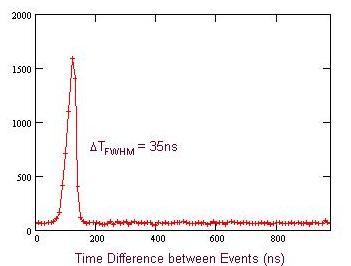![[Dr Reddish's Research Home page]](mcp-logo.gif) |
![[Dr Reddish's Research Home page]](mcp-logo.gif) |
 In coincidence
measurements - such as in photodouble ionisation - one needs to ensure
that two (or more) particles are associated with the same physical event.
In photoelectron-photoelectron coincidence spectroscopy the two ejected
electrons are time correlated in the following manner: An electron arriving
at one detector starts a ‘clock’ and the next electron arriving at a second
detector stops it. This is repeated and a distribution of time intervals
is accumulated. If the two electrons are from different atoms then the
distribution of time intervals will show no correlation, resulting in a
flat background of ‘random’ counts. But if the two electrons are from the
same atom then a specific time correlation can be expected, resulting in
a ‘true’ coincidence peak. In our experiment we record time interval (t)
and the corresponding positions (x1,y1, x2,y2)
of electron pairs with specific energies (E1, E2).
Our coincidence count rates are typically between 0.02 - 2.0 events per
second.
In coincidence
measurements - such as in photodouble ionisation - one needs to ensure
that two (or more) particles are associated with the same physical event.
In photoelectron-photoelectron coincidence spectroscopy the two ejected
electrons are time correlated in the following manner: An electron arriving
at one detector starts a ‘clock’ and the next electron arriving at a second
detector stops it. This is repeated and a distribution of time intervals
is accumulated. If the two electrons are from different atoms then the
distribution of time intervals will show no correlation, resulting in a
flat background of ‘random’ counts. But if the two electrons are from the
same atom then a specific time correlation can be expected, resulting in
a ‘true’ coincidence peak. In our experiment we record time interval (t)
and the corresponding positions (x1,y1, x2,y2)
of electron pairs with specific energies (E1, E2).
Our coincidence count rates are typically between 0.02 - 2.0 events per
second.